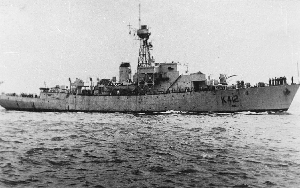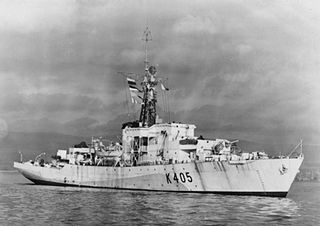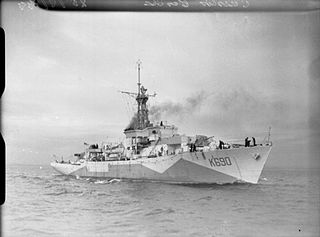
HMS Bamborough Castle was one of 44 Castle-class corvettes built for the Royal Navy during World War II. Completed in mid-1944 she sank the U-boat U-387 on 9 December. Aside from a brief period assigned to the Fishery Protection Squadron in 1946, the rest of her career was spent as part of the fleet reserve until she was scrapped in May 1959.
HMS Allington Castle was one of 44 Castle-class corvette built for the Royal Navy during the Second World War. She was named after Allington Castle in Kent. Completed in 1944, she served as a convoy escort during the war and on fishery patrol duties in 1945–1947, being sold for scrap in 1958.

HMS Alnwick Castle was one of 44 Castle-class corvettes built for the Royal Navy during the Second World War. She was named after Alnwick Castle in Northumberland. Completed in late 1944, the ship served as a convoy escort until the end of the war, helping to sink one German submarine. The corvette was placed in reserve after the war and was sold for scrap in 1958.

HMS Flint Castle (K383) was one of 44 Castle-class corvettes built for the Royal Navy during World War II. Completed at the end of 1943, the ship ran aground while training in January 1944. After repairs were completed the following month, she was briefly assigned to the 39th Escort Group for convoy escort duties in the Atlantic Ocean. Flint Castle was transferred to Escort Group B2 in March and screened convoys to and from Gibraltar until September. That month, she joined Escort Group B3 to escort convoys between Canada and Britain and continued to do so until the end of the war in May 1945. The ship then became an anti-submarine training ship in Rosyth and Campbeltown, Scotland, before moving to Portland at the beginning of 1947. Flint Castle remained there until she was taken out of service in March 1956 and broken up beginning in July 1958.

HMS Caister Castle was one of 44 Castle-class corvettes built for the Royal Navy during World War II.
HMS Carisbrooke Castle (K379) was one of 44 Castle-class corvettes built for the Royal Navy during World War II.

HMS Hurst Castle (K416) was one of 44 Castle-class corvettes built for the Royal Navy during World War II. Completed in June 1944, she began escorting convoys in August and was sunk by a German U-boat the following month.

HMS Zealous was a Z-class destroyer of the Royal Navy built in 1944 by Cammell Laird. She served during the Second World War, participating in operations in the North Sea and off the Norwegian coast, before taking part in some of the Arctic convoys. She spent a further ten years in Royal Navy service after the end of the war before being sold to the Israeli Navy, which operated her as INS Eilat. She saw action during the Suez Crisis in 1956 attacking Egyptian ships, and was still active by the outbreak of the Six-Day War in 1967. She was sunk several months after the conflict by missiles launched from several small Egyptian missile boats; this made her the first vessel to be sunk by a missile boat in wartime. It was an important milestone in naval surface warfare, which aroused considerable interest around the world in the development of small manoeuvrable missile boats.
HMS Marigold was a Flower-class corvette of the Royal Navy. She was launched on 4 September 1940 and was sunk by an Italian air-dropped torpedo on 9 December 1942.

HMS Westcott (D47) was a Royal Navy Admiralty W-class destroyer that served in the Second World War. In the Second World War Westcott served in an anti-submarine role and escorted numerous Atlantic and Malta convoys.
HMS Dumbarton Castle (K388) was one of 44 Castle-class corvettes built for the Royal Navy during World War II. She saw action in the Battle of the Atlantic during the war.

Empire Lifeguard (K443) was a convoy rescue ship of the Second World War. Initially built as HMS Maiden Castle - one of 44 Castle-class corvette built for the Royal Navy - she was completed in 1944 as a convoy rescue ship to pick up survivors from attacks on the convoys. Operated for the Ministry of War Transport (MoWT) she served in this role with convoys during the war. Post war she was operated as a transport in the Mediterranean. She was damaged by a terrorist attack and sunk in 1947 but repaired and ultimately sold for scrap in 1955.

HMS Shrewsbury Castle was one of 44 Castle-class corvette built for the Royal Navy during the Second World War. She was named after Shrewsbury Castle in Shrewsbury. Completed in 1944, she was loaned to the Royal Norwegian Navy as a convoy escort during the war, renamed HNoMS Tunsberg Castle and was sunk by a mine in December 1944.

HMS Morpeth Castle was one of 44 Castle-class corvette built for the Royal Navy during the Second World War. She was named after Morpeth Castle in Morpeth. Completed in 1943, she was used as a convoy escort during the war and was scrapped in August 1960.
HMS Tintagel Castle was one of 44 Castle-class corvette built for the Royal Navy during the Second World War. She was named after Tintagel Castle in Tintagel. Completed in 1943, she was used as a convoy escort during the war and was scrapped in August 1960.

HMS Pink was a Flower-class corvette that served in the Royal Navy. She was built by Henry Robb in Leith in 1941 and named after the flower nicknamed garden pink. She was commissioned in 1942 and scrapped in 1947.
HMS Auricula was a Flower-class corvette that served in the Royal Navy and was built by George Brown and Company in 1940. She was named after Auricula. Commissioned in 1941 and sunk by a mine on 6 May 1942.

HMS Asphodel was a Flower-class corvette that served in the Royal Navy and was built by George Brown and Company in 1940. She was named after Asphodel. Commissioned in 1940 and sunk by U-575 on 10 March 1944.

HMS Serapis was an S-class destroyer of the British Royal Navy. The ship was built by Scotts Shipbuilding and Engineering Company from 1941 to 1943, and was launched on 25 March 1943 and completed on 25 December 1943.

HMS Petunia (K79) was a Flower-class corvette that served in the Royal Navy and was built by Henry Robb in 1940. She was named after Petunia. Commissioned in 1940, rammed and sold to the Chinese Nationalist Government and renamed ROCS Fu Bo.














